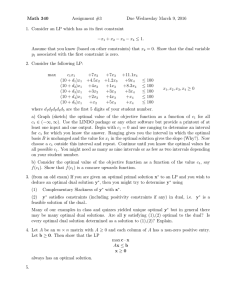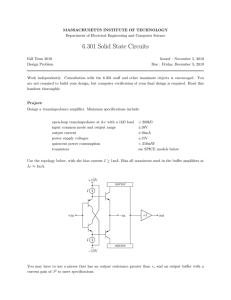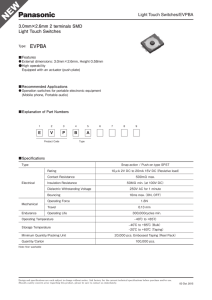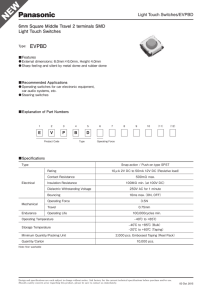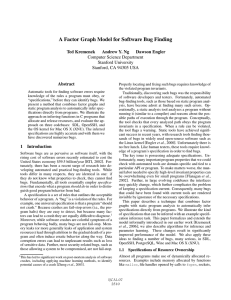Massachusetts Institute of Technology
advertisement
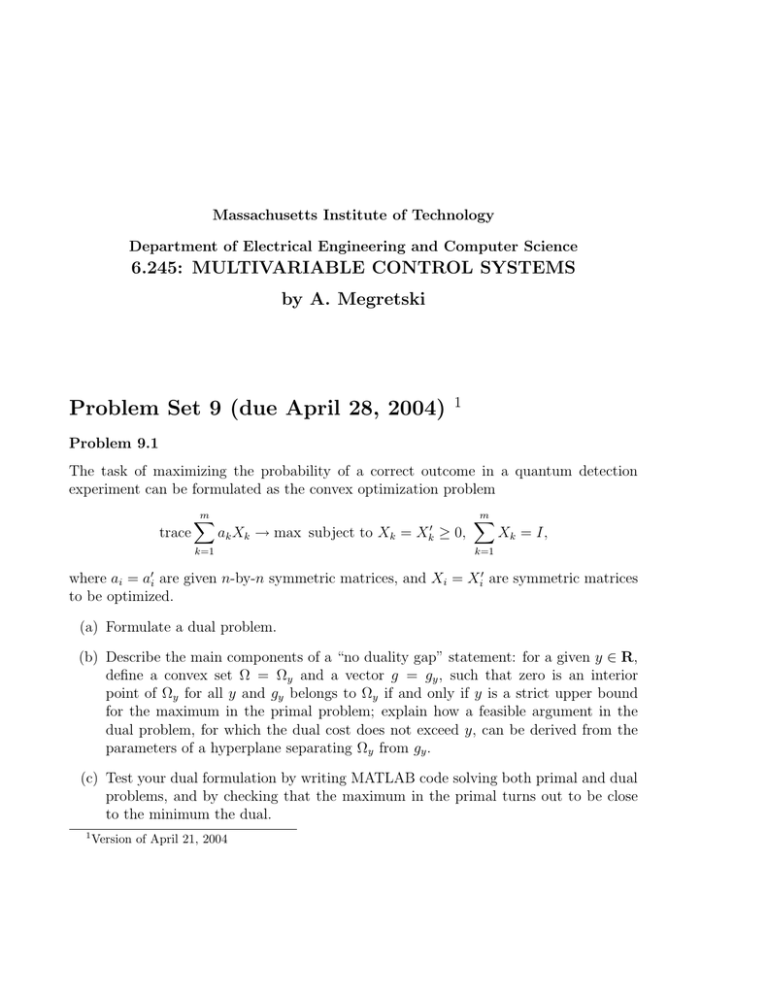
Massachusetts Institute of Technology Department of Electrical Engineering and Computer Science 6.245: MULTIVARIABLE CONTROL SYSTEMS by A. Megretski Problem Set 9 (due April 28, 2004) 1 Problem 9.1 The task of maximizing the probability of a correct outcome in a quantum detection experiment can be formulated as the convex optimization problem trace m ⎥ ak Xk � max subject to Xk = k=1 Xk ∀ 0, m ⎥ Xk = I, k=1 where ai = ai are given n-by-n symmetric matrices, and Xi = X i are symmetric matrices to be optimized. (a) Formulate a dual problem. (b) Describe the main components of a “no duality gap” statement: for a given y → R, define a convex set � = �y and a vector g = gy , such that zero is an interior point of �y for all y and gy belongs to �y if and only if y is a strict upper bound for the maximum in the primal problem; explain how a feasible argument in the dual problem, for which the dual cost does not exceed y, can be derived from the parameters of a hyperplane separating �y from gy . (c) Test your dual formulation by writing MATLAB code solving both primal and dual problems, and by checking that the maximum in the primal turns out to be close to the minimum the dual. 1 Version of April 21, 2004 2 Problem 9.2 The open loop plant has scalar input u, scalar output y, and transfer function P (s) = s−1 . s(s − 2) The objective is to design a proper LTI controller K, with inputs r (the reference signal) and y, and output u, to satisfy the following specifications: (i) the resulting closed loop system is stable; (ii) the absolute value |mu (t)| of the closed loop unit step response mu = mu (t) from r to u never exceeds 10; (iii) the value my (t) of the closed loop unit step response my = my (t) from r to y never leaves the interval [−1, 2]. The design objective is to minimize, subject to the specifications given above, the closed loop settling time, defined as the minimal T ∀ 0 such that |1 − my (t)| � 0.1 � t ∀ T. (a) Derive Q-parameterization for all closed loop transfer matrices from r to z = [y; u] achievable by a stabilizing controller; (b) Explain how linear programming and the Q-parameterization can be used to find lower bounds T0 of arbitrary relative accuracy for the minimal achievable (subject to specifications (i)-(iii)) settling time T� ; (c) Explain how linear programming and Q-parameterization can be used to find fi­ nite order controllers which achieve near-optimal (subject to specifications (i)-(iii)) settling times; (d) Implement the algorithms from (a) and (b) in MATLAB to find a controller with a guaranteed level of optimality (subject to specifications (i)-(iii)) for the settling time. 3 Problem 9.3 It is known that, for a stable LTI system G = [G1 G2 . . . Gm ] with m scalar inputs w1 , w2 , . . . , wm and one output e, the maximal energy E = E(G) of e achievable (subject to zero initial conditions) when the energy of each of the signals w k is bounded by one, equals the supremum of the square of the H-Infinity norm of G� = [�1 G1 �2 G2 . . . �m Gm ], where �k > 0 are positive numbers satisfying m ⎥ 1 = 1. �2 k=1 k (a) Explain how the KYP lemma can be used to reduce the task of finding E = E(G), where G is given by its state space model � ⎤ w1 ⎢ � e = Cx + Dw, ẋ = Ax + Bw, w = � ... ⎣ , wm to semidefinite programming; (b) Implement the algorithm from (a) in MATLAB, and test it on G(s) = [s s − 1] . s2 + s + 1



